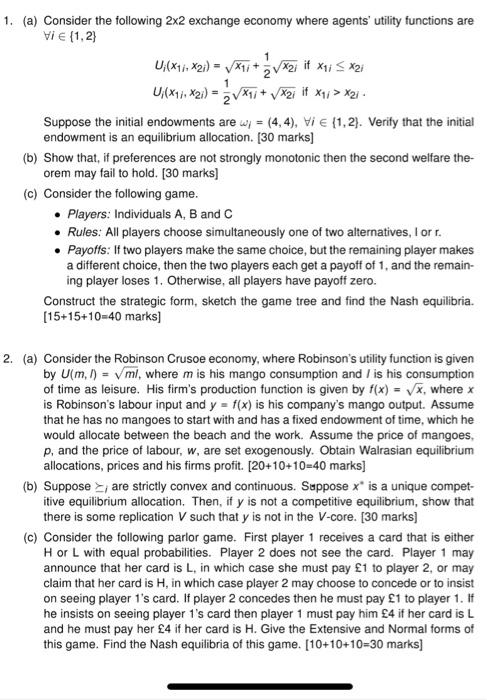Answered step by step
Verified Expert Solution
Question
1 Approved Answer
Question one a,b and 2a ,b are general equilibrium questuon the others are game theory 1 1. (a) Consider the following 2x2 exchange economy where

Question one a,b and 2a ,b are general equilibrium questuon the others are game theory
1 1. (a) Consider the following 2x2 exchange economy where agents utility functions are Vi (1,2) U;(X1, X2i) = X11+ X2} if X1 X2i U;(*11*21) = av X1 + X2; if X1;> X21. Suppose the initial endowments are w1 = (4,4), Vi (1,2). Verify that the initial endowment is an equilibrium allocation. (30 marks) (b) Show that, if preferences are not strongly monotonic then the second welfare the- orem may fail to hold. (30 marks) (c) Consider the following game. Players: Individuals A, B and C Rules: All players choose simultaneously one of two alternatives, lort. Payoffs: If two players make the same choice, but the remaining player makes a different choice, then the two players each get a payoff of 1, and the remain- ing player loses 1. Otherwise, all players have payoff zero. Construct the strategic form, sketch the game tree and find the Nash equilibria. (15+15+10-40 marks) 2. (a) Consider the Robinson Crusoe economy, where Robinson's utility function is given by Ulm, 1) = V ml, where mis his mango consumption and / is his consumption of time as leisure. His firm's production function is given by f(x) = x, where is Robinson's labour input and y = f(x) is his company's mango output. Assume that he has no mangoes to start with and has a fixed endowment of time, which he would allocate between the beach and the work. Assume the price of mangoes, p, and the price of labour, w, are set exogenously. Obtain Walrasian equilibrium allocations, prices and his firms profit. [20+10+10=40 marks] (b) Suppose , are strictly convex and continuous. Suppose x is a unique compet- itive equilibrium allocation. Then, if y is not a competitive equilibrium, show that there is some replication V such that y is not in the V-core. (30 marks] (c) Consider the following parlor game. First player 1 receives a card that is either Hor L with equal probabilities. Player 2 does not see the card. Player 1 may announce that her card is L, in which case she must pay 1 to player 2, or may claim that her card is H, in which case player 2 may choose to concede or to insist on seeing player 1's card. If player 2 concedes then he must pay 1 to player 1. If he insists on seeing player 1's card then player 1 must pay him 4 if her card is L and he must pay her 4 if her card is H. Give the Extensive and Normal forms of this game. Find the Nash equilibria of this game. [10+10+10=30 marks) 1 1. (a) Consider the following 2x2 exchange economy where agents utility functions are Vi (1,2) U;(X1, X2i) = X11+ X2} if X1 X2i U;(*11*21) = av X1 + X2; if X1;> X21. Suppose the initial endowments are w1 = (4,4), Vi (1,2). Verify that the initial endowment is an equilibrium allocation. (30 marks) (b) Show that, if preferences are not strongly monotonic then the second welfare the- orem may fail to hold. (30 marks) (c) Consider the following game. Players: Individuals A, B and C Rules: All players choose simultaneously one of two alternatives, lort. Payoffs: If two players make the same choice, but the remaining player makes a different choice, then the two players each get a payoff of 1, and the remain- ing player loses 1. Otherwise, all players have payoff zero. Construct the strategic form, sketch the game tree and find the Nash equilibria. (15+15+10-40 marks) 2. (a) Consider the Robinson Crusoe economy, where Robinson's utility function is given by Ulm, 1) = V ml, where mis his mango consumption and / is his consumption of time as leisure. His firm's production function is given by f(x) = x, where is Robinson's labour input and y = f(x) is his company's mango output. Assume that he has no mangoes to start with and has a fixed endowment of time, which he would allocate between the beach and the work. Assume the price of mangoes, p, and the price of labour, w, are set exogenously. Obtain Walrasian equilibrium allocations, prices and his firms profit. [20+10+10=40 marks] (b) Suppose , are strictly convex and continuous. Suppose x is a unique compet- itive equilibrium allocation. Then, if y is not a competitive equilibrium, show that there is some replication V such that y is not in the V-core. (30 marks] (c) Consider the following parlor game. First player 1 receives a card that is either Hor L with equal probabilities. Player 2 does not see the card. Player 1 may announce that her card is L, in which case she must pay 1 to player 2, or may claim that her card is H, in which case player 2 may choose to concede or to insist on seeing player 1's card. If player 2 concedes then he must pay 1 to player 1. If he insists on seeing player 1's card then player 1 must pay him 4 if her card is L and he must pay her 4 if her card is H. Give the Extensive and Normal forms of this game. Find the Nash equilibria of this game. [10+10+10=30 marks) Step by Step Solution
There are 3 Steps involved in it
Step: 1

Get Instant Access to Expert-Tailored Solutions
See step-by-step solutions with expert insights and AI powered tools for academic success
Step: 2

Step: 3

Ace Your Homework with AI
Get the answers you need in no time with our AI-driven, step-by-step assistance
Get Started


